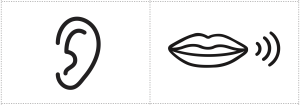 Juno and Rosie’s preschool teacher shows them the shape pictured at right and asks whether it is a triangle. The teacher wants Juno and Rosie to pause, reflect, and think about the answer before responding. One strategy to achieve this goal is called Think-Pair-Share. [This example is from the DREME Guided Small Group Math Activity: True or Trick?]
Juno and Rosie’s preschool teacher shows them the shape pictured at right and asks whether it is a triangle. The teacher wants Juno and Rosie to pause, reflect, and think about the answer before responding. One strategy to achieve this goal is called Think-Pair-Share. [This example is from the DREME Guided Small Group Math Activity: True or Trick?]
What Is Think-Pair-Share?
Think-Pair-Share is a strategy to promote reflection and turn-taking. It works by guiding children to pause and silently think about their response to a question, and then share their ideas with a partner [1]. To use this strategy, the teacher first asks a question, then prompts children to complete the three steps in Think-Pair-Share. The strategy works in Whole or Small Group settings and can be used with preschoolers and older children.
Think-Pair-Share is a helpful way to keep all children engaged in an activity. For example, during Whole Group, instead of only one or two children sharing ideas, all children get to share their ideas. Teachers arrange the pairs based on the activity and what they know about the children in their classroom.
Figure 1. Think-Pair-Share cards

How Does Think-Pair-Share Engage Children’s Executive Function and Math Skills?
- Think-Pair-Share offers children opportunities to reflect on what they know about math concepts, which can strengthen children’s understanding of these ideas. Psychologists define reflection as intentionally stopping and pausing to think deeply before acting.
- Keeping track of the teacher’s question while also thinking about their own ideas is an example of children using working memory—an executive function skill.
- Silently thinking about the question rather than immediately responding, taking turns sharing ideas, and listening to peers are all ways to practice inhibitory control—another executive function
What Does Think-Pair-Share Look Like in Preschool Classrooms?
Introducing Think-Pair-Share. We developed this resource to help teachers guide children through the process. Teachers can also use the optional Think-Pair-Share cards (Figure 1) while explaining and modeling Think-Pair-Share. The Listen and Speak cards (Figure 2) can be used during each step to remind children if it’s time to listen or share their ideas.
Using Think-Pair-Share. Here is an example of a teacher using Think-Pair-Share while engaging with Juno and Rosie in the opening vignette:
- “This is a triangle. True or trick? Think-Pair-Share with your partner. Why or why not?”
- “Remember, in Think-Pair-Share, we start by using our brains to think quietly about our ideas.” (Give children time to think.)
- “Please pair up with your partner.” (Juno and Rosie turn toward each other.)
- “Now it’s time to take turns sharing ideas.” (Juno and Rosie take turns answering and listening to each other.)
Figure 2. Listen and Speak cards

Think-Pair-Share can be used in many classroom math activities, centers, or routines (and in activities that are not about math!). For example, the Juno and Rosie example is from the DREME Guided Small Group Math Activity: True or Trick. In the DREME Math Moment: What Shape Am I Thinking Of?, teachers can encourage children to Think-Pair-Share to figure out which shape the teacher is thinking of based on clues she provides. See more ideas for using Think-Pair-Share in the set of DREME Guided Small Group Math Activities.
Reference:
[1] Lyman, F. T. (1981). The responsive classroom discussion: The inclusion of all students. In A. S. Anderson (Ed.), Mainstreaming Digest (pp. 109–113). University of Maryland Press.